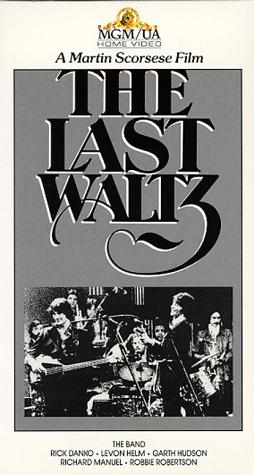
The Last Waltz (1978)

Martin Scorsese combines his twin passions of movies and rock 'n' roll in The Last Waltz, a stylish and elegiac mix of interviews, studio-shot production numbers, and expertly filmed footage of The Band's 1976 farewell concert, in which they were joined by more than a dozen guest stars, including Bob Dylan, Neil Young, and Eric Clapton. After an on-screen message that reads "This Film Should Be Played Loud," The Band performs "Don't Do It," and Robbie Robertson, the group's leader, tells director-interviewer Martin Scorsese why they're calling it quits after 16 years on the road.
The group is then seen at their farewell concert, given at San Francisco's Winterland Arena on Thanksgiving, performing "Up On Cripple Creek" and "Shape I'm In." Singer Ronnie Hawkins joins The Band for "Who Do You Love." After performing "It Makes No Difference," Dr. John sings "Such a Night" and Neil Young comes out to do "Helpless." The Band performs "Stagefright" and discuss how they got their name, which was originally "The Hawks." On a soundstage, The Staples join them for a rendition of "The Weight," and back at the Winterland, they do "The Night They Drove Old Dixie Down." Reminiscences of The Band's first trip to New York and Tin Pan Alley leads to a Neil Diamond performance of "Dry Your Eyes." Joni Mitchell sings "Coyote," and Paul Butterfield plays the harp on "Mystery Train." A discussion of the influence on their music of Southern blues, country, and jazz leads to Muddy Waters performing "Mannish Boy"; Eric Clapton doing "Further On Up the Road"; Emmylou Harris joining in for "Evangeline" (in another studio-set number), and a performance of "Ophelia." After Van Morrison sings "Caravan," Bob Dylan comes on to do three songs: "Forever Young," "Baby Let Me Follow You Down," and the finale, "I Shall Be Released," for which all of the previous performers come back onstage, joined by Ringo Starr and Ron Wood. Back in the studio, The Band performs an instrumental number called "Theme From 'The Last Waltz'"
Following the financial disaster of his first big-budget Hollywood production, New York, New York (1977), and the concomitant studio editing, Scorsese returned to his early roots. He had been an editor on Woodstock (1970) and Elvis on Tour (1972), and sought refuge in assembling The Band's concert footage, which was shot in 1976. Made contemporaneously with New York, New York, The Last Waltz has much in common with the former, most notably in the clash of styles which represent Scorsese's two poles of cinematic influence: raw, Cassavetes-like intimacy and improvisation (the candid, if somewhat self-consciously spontaneous, interviews with The Band); and flamboyant, Visconti-Minnelli-Powell-like mise-en-scene (the concert set from La Traviata replete with giant red curtains and chandeliers; the elegantly choreographed soundstage production numbers; and the anachronistic reading of Chaucer's The Canterbury Tales, which was made into a film by Michael Powell in 1944).
Promoted at the time as being the first concert documentary to be filmed in 35 millimeter (by a team of A-list Hollywood cinematographers), the production was also the first to utilize a 24-track recording system, which was then mixed down to 4-track Dolby stereo. From a technical perspective, the result is undoubtedly the most impressive and authentic concert film ever made, with the use of 35mm. film creating a palpable sense of immediacy. Scorsese indulges himself with a profusion of tracking shots, lighting changes, and cross-cutting of varying angles (particularly during the highly stylized studio numbers), yet makes sure to keep the focus on the performers, allowing the music to speak for itself.
While it certainly helps to be a fan of The Band, it's not essential in order to appreciate the film's eloquent accomplishments. The guest stars, a veritable who's who of 1960s legends, are all outstanding, most notably Neil Young, Joni Mitchell, and especially, Bob Dylan, whom The Band backed up for years. When Dylan is joined by everyone at the end for "I Shall Be Released," the film reaches an emotional and spiritual epiphany and creates a true sense of social and musical history. It also achieves a genuinely mournful and poetic tone, through its "end-of-an-era" interviews and parade of guest stars--representing, as they do, the last vestiges of the idealistic, peace-and-love Woodstock Generation as it slowly fades away on the eve of the Reagan Revolution. In retrospect, the film is even more poignant, given subsequent events, including The Band's ironic, partial reunion (sans Robertson), and the suicide of one of its members, Richard Manuel.
Performers:
The Band
Bob Dylan
Neil Young
Joni Mitchell
Van Morrison
Eric Clapton
Neil Diamond
The Staples
Muddy Waters
Emmylou Harris
Paul Butterfield
Dr. John
Ronnie Hawkins
Ringo Starr
Ron Wood
Levon Helm
Martin Scorsese
Production Credits:
Producers, Joel Chernoff (uncredited), L.A. Johnson (line), Robbie Robertson and Jonathan T. Taplin (executive)
Director, Martin Scorsese
Cinematography, Michael W. Watkins and Vilmos Zsigmond
Production Design, Boris Leven
Sound Department, Stephen Katzand Steve Maslow.